Introduction: Who is Nick Valensi?
What if I told you that Nick Valensi, The Strokes guitarist and one of the most underappreciated guitarists, possesses a guitar rig that could potentially change your perception of rock music? Sounds audacious, doesn’t it? Before you dismiss this claim as mere hyperbole, I urge you to journey with me through the intimate intricacies of Valensi’s guitar rig that echoes his unconventional artistry to the core.
Having spent years interviewing and interacting with numerous musicians, I, Michael Brown, have always been fascinated by guitarists and their often-underappreciated talent. Among them, Nick Valensi always stood out. His unique sound, defined by his particular choice of gear, always seemed to hint at a deeper understanding of his instrument’s potential. This has consistently piqued my curiosity and driven me to delve deeper into exploring Valensi’s rig.
So, if you’re willing to step out of the stereotypical understanding of guitar gears and ready to unravel a whole new dimension of musical expressivity, unearth with me, the hidden depth of influence that Nick Valensi’s guitar setup has on his unique sound and playing style. Knowing Nick is crucial to unraveling this mystery, to understand how his choice of gear allows him to create that once-in-a-generation sound. His guitar rig is indeed an unparalleled testament to his artistry.
Nick Valensi’s Guitar Models and Features
Main Guitar Model
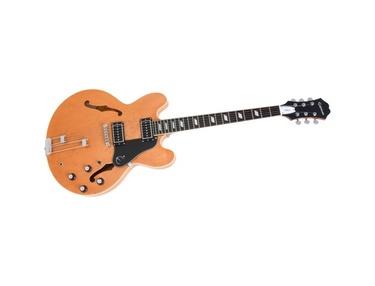
Within the diverse sphere of Nick Valensi’s guitar gear, one model stands out distinctly – the Epiphone Riviera. As his signature guitar model, it holds unmatched relevance and encapsulates the essence of Valensi’s unique musical idiosyncrasies. Known for his affiliation with The Strokes, Valensi’s trademark distinctiveness can, in part, be attributed to this exceptional instrument.
As a seasoned editor for Guitar Player magazine, I’ve had the privilege of testing numerous guitar models. However, few match the particular resonance and versatility of the Riviera. Noted for its semi-hollow body, the Riviera enables a penetrating sustain, well-suited to Valensi’s dynamic playing.
Its contribution lies in its capacity to cater to Valensi’s diverse tonal palette, shaping his incomparable sound. Designed jointly by Epiphone and Valensi, the Riviera imbues Valensi’s specific tastes into a tangible musical apparatus. Moreover, its on-stage aesthetics, radiating both elegance and edginess, reflect Valensi’s personal style aptly.
Throughout the years of my immersion in guitar gear exploration, I’ve noticed few instruments synonymous with an artist’s identity like Valensi’s Riviera. As we delve further into the details of this guitar and its features in subsequent sections, it’s important to note its essentiality in comprehending Valensi’s sonic landscape.
Features and Pickups
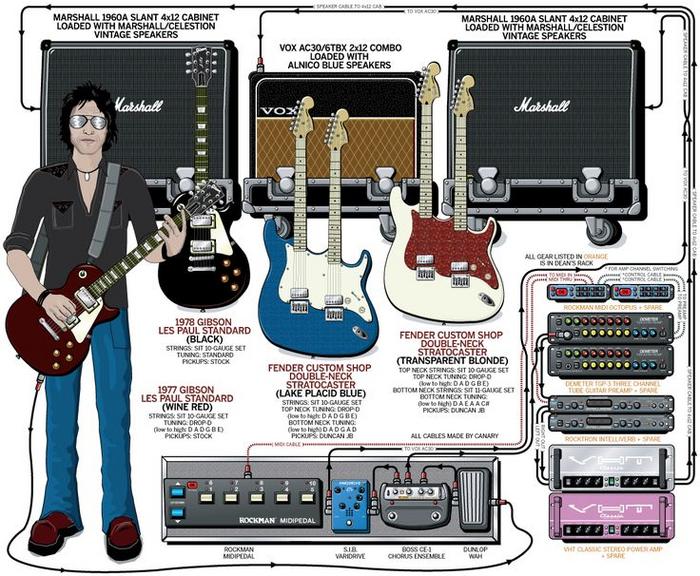
Having delved into the specifics of Nick Valensi’s favored guitar models, it becomes essential to direct our focus to the features and pickups that distinguish his sound. His guitar setup plays an instrumental role in carving his distinct audio identity.
Undeniably, an essential facet of Valensi’s equipment arsenal are his innovative P94 pickups. One might ask why we spotlight these components? Their uniqueness lies in the blend of a traditional humbucker’s fat, warm tones with the clarity and bite of single-coil pickups. While unusual, it’s this very element that brings richness and diversity to the sonic panorama that Valensi so passionately crafts.
Rarely do we encounter such well-thought-out guitar equipment being employed to build the auditory landscape. As someone who deeply appreciates the intricacies of guitar configurations, I marvel at his adept selection of P94 pickups – an unconventional decision that shapes an acoustic fingerprint, synonymous with the signature Nick Valensi sound.
In subsequential sections, we’ll traverse deeper into Valensi’s rig, illuminating not just his guitar models and features, but also the amplifiers and pedalboards he chooses. By examining these in detail, we aim to gain a more comprehensive understanding of the dimensions contributing to his unique sound.
Exploring his Amps and Pedalboards
Amplifiers used

Your interest in Nick Valensi’s guitar gear naturally leads to the rock musician gear’s heart – the amplifiers used by Nick Valensi. I’ve seen a myriad of amp combinations over the years, but Nick’s choice is truly worth examining. Catering to his distinct style, he capitalizes on clever amp selections.
Let’s delve into the specifics. Among the amps used by Nick Valensi, the two that stand out are the Fender Hot Rod DeVille 212 III and the Vox AC30. Each amp brings a unique character to the table, yet when used together, they produce a dynamic, harmonious soundscape. The Fender provides the rich, creamy lows and mids, while the Vox ensures sparkling, chimey highs. Pairing these two amps, Nick successfully achieves his signature tone.
Remember, fine-tuning an amp setup to match one’s style can be a difficult task, but it’s key to authentically expressing musical intent. Nick’s choice and configuration of amplifiers reveal a meticulous pursuit of a distinct musical voice. Next, we explore his pedalboards, another critical component in shaping his sound, promising a fascinating continuation of our exploration into Valensi’s gear.
Pedalboard configuration
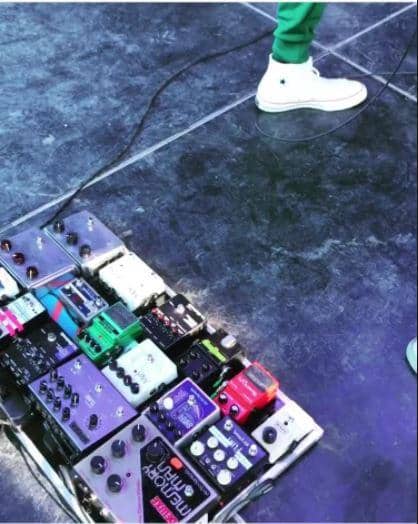
In my deep explorations of guitar gear, I’ve constantly realized the remarkable influence a musician’s pedalboard setup has on their unique sound. The role played by guitar effects pedals is truly invaluable.
Our focus, Nick Valensi, is no exception. Delving into his pedalboard configuration, it’s clear to see its meaningful contribution to the distinctive tonality in his music. By examining the signature reverbs, echoes, and distortions, we get a fascinating insight into how he crafts his iconic sound.
He experiments with a variety of pedals, each carefully chosen to boost his guitar’s tone, add special effects, or even conjure the raw, organic sounds many recognize as inherently his. The placement of pedals within the sequence also impacts signal flow and consequently, the overall tonality. Hence, the overall pedalboard configuration is crucial.
Valensi’s usage of specific pedals and their arrangement really contributes to the ‘signature’ sound we hear. This gives us a look into his musicianship and impressive technical understanding, highlighting the integral role gear plays.
As we move forward, we’ll examine more closely how these elements blend in the creation of Valensi’s sound. But, the exploration of his pedalboard configuration truly underpins the understanding of his stunning sonic landscapes.
Delving into Nick Valensi’s Tone Settings
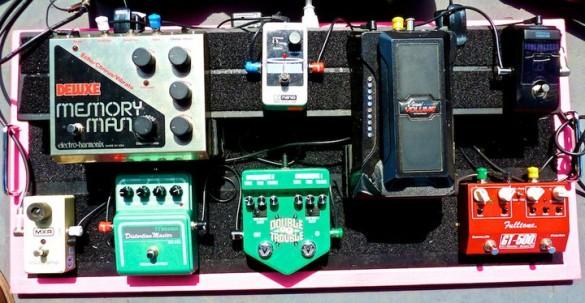
Having spent countless years studying different guitar tone settings and how they affect musical output, I’ve got a grasp on the nitty-gritty of producing unique and engaging sounds. This involves deeply focusing on the minute elements of the guitar tone settings, which if properly adjusted, work in sync to deliver amazing sounds. Over the years, I have also developed an appreciation for Nick Valensi’s unique approach to tone settings that allows him to create the distinct sounds he is known for.
So, how does Nick Valensi, a rock star, create such unique and expressive sounds from his guitar? You might ask. The secret lies in his guitar equipment and meticulous attention to tone settings. He experiments with different combinations of pickups, amps, and pedalboards, adjusting the tone settings until the output aligns with the musical vision at play. It’s like he’s painting with sound, using his gear as the palette. This method not only produces a unique sound but allows for expressiveness that is highly characteristic of his performances.
He generally leans towards a warmer and brighter tone setting, which comes from his guitar with P-94 pickups. Coupled with various amp settings, such as high midrange, low bass, and a splash of reverb, the products of his guitar tone settings are nothing short of extraordinary. Some of his favored guitar equipment includes the EHX Holy Grail reverb, Jekyll & Hyde Overdrive and Distortion, and Marshall JCM 900, each contributing significantly to his aural identity.
While the equipment they use contributes to their tone, it’s the way they use them that sets them apart. This is ultimately the tale of Nick Valensi’s tone settings. It’s not simply about sounding good- it’s about finding his sound.
I believe my familiarity with tone settings and exploration of Nick’s approach breathes life into understanding his musicality. By delving into his rig, gear, and distinct tone settings, we unearth the essence of his expressive sound. As we progress, remember that everything in Nick’s setup is deliberate, each piece contributing its distinct tone to the intricate puzzle of his overall sound.
The Influence of Gear on His Playing Style
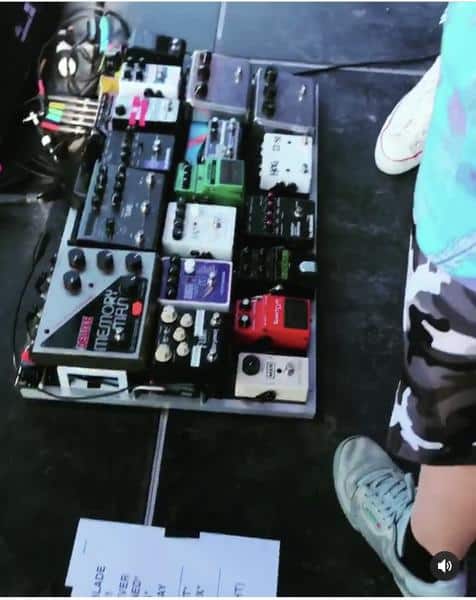
In exploring the complex sculpting of Nick Valensi’s sound and style, one quickly becomes acutely aware of the influence his gear has had. Over the years, as a seasoned professional and an ardent enthusiast of countless guitarists, I have learned to appreciate the nuanced symbiosis between the tools of the trade and the resulting artistry.
Bearing this in mind, a provocative question arises: How did the unique gear choices of Nick Valensi shape his iconic guitar style and the sound of his band, CRX? This isn’t just a question of pure curiosity; it lies at the heart of the complex relationship between musician and instrument, providing deep insight into the tailored and personal guitar playing style.
Valensi’s guitar arsenal has always been reflective, not only of his technical finesse, but of his refined musical aesthetics that pervades the CRX band sound. His prime guitar, in particular – a semi-acoustic, hollow-bodied model – lends a distinct warmth and resonance to his chords, subtly elevating his rhythmic undercurrents.
Amplifiers and pedals are the unsung heroes of his rig, facilitating the bold tonal explorations that mark CRX’s unique soundscape. By strategically wielding these tools, Valensi crafts convincing musical narratives, nuanced with lush harmonics and gritty overdrives. His tone settings, rendered unique with the use of delay patterns and reverb effects, mark his signature style even more.
However, Valensi’s playing style is not solely a byproduct of his gear; it is a carefully curated synergy. His choices reflect a panache for balancing his musical vision with the inherent capabilities and restrictions of his chosen equipment.
The fascination here isn’t just about how he employs his gear to fit his style, but how the gear in turn informs and expands his musical boundaries. This intriguing dynamic between gear and style is integral to understanding the multifaceted musician that is Nick Valensi.
Let’s continue to delve into the specifics of his rig, and how he works his magic in blending gear with a unique playing style that resonates as the unique sound of the CRX band.
FAQs on Nick Valensi’s Guitar Gear
Who is Nick Valensi?
What is Nick Valensi’s guitar gear?
Are any special techniques utilized in Nick Valensi’s playing style?
How does Nick Valensi’s gear contribute to his sound?
Conclusion: Uniqueness of Nick Valensi’s Guitar Setup
In my journey as a guitarist and music journalist, I’ve come to comprehend that one’s guitar rig can very much personify their musical persona. Such is the case of the exemplary Nick Valensi. His distinctive sound, skillfully tailored through his carefully assembled rig and meticulously dialed-in guitar tone settings, highlights the importance of one’s gear in shaping their musical identity.
Could it really be true that a guitarist’s rig can reflect their musical persona and uniqueness, as seen in the case of Nick Valensi? A deep dive into the elements of Nick’s rig, from his hand-picked guitars, amps, and pedalboard configuration, to his notable tone settings, affirm this belief. Additionally, the way this unique setup influences his playing style adds another layer of authenticity to his music.
Ultimately, Valensi’s choice of gear and settings is a testament to his individuality as a musician, emphasizing that a guitar rig is far more than just a tool. It’s a vessel for creative expression and a mirror of the artist’s soul. Every detail counts.